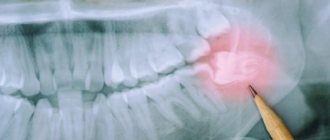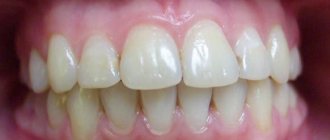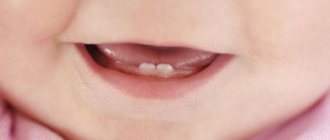Wisdom teeth or “eight” teeth grow in adults. By this age, the jaw is fully formed, there are 28 permanent teeth. Eruption takes about a month and a half, then roots form within 3-4 years. The first period is almost always accompanied by painful sensations and inflammatory processes. During root formation, discomfort rarely occurs. In the case of pathological eruption, inflammation and pain may continue for a long time. Whether discomfort is an indication for removal of the “eight” will be determined by the doctor during a diagnostic examination.
Features of wisdom tooth eruption
Wisdom teeth or third molars, also known as figure eights, are the outermost teeth in a row, located at the edges of each jaw. There are four of them in total, but often not all of them erupt, and sometimes they may not grow at all.
This will not affect the chewing functions of the jaw, and if you do not have a single eight, there is no need to sound the alarm.
The eruption of third molars is possible at any age, even after 30 years; the patient’s age does not affect the course of the process. But the direction of growth, the presence of free space in a row, the structural features of the jaw can significantly influence the process - will it be painful or will it go unnoticed, will there be a health hazard and will the growth provoke the development of inflammation.
How long will the cutting and toothache last?
The process of cutting through the figure eight is long and highly individual. In some patients it “appears” in 3–4 months, in others it may take 1–2 years, and in others it remains incompletely erupted. Quite often, a wave-like “appearance” of the third molar is observed - either it is intensively cut, or it freezes.
As for severe pain, as a rule, it is present only at the beginning of the process - at the stage when the figure eight cuts through the dense gum tissue. And again, this moment can happen quite quickly or drag on for a long time.
When the first signs of figure eight eruption appear, it is better not to postpone a visit to the doctor. Even if the process does not cause severe pain or discomfort, it is better to show it to the dentist. An experienced specialist will examine the condition of the third molar and provide assistance that will facilitate the process of “the birth of the tooth.”
Pathologies that require dental care
Eights can take several days, months, or even years to erupt. Growth is accompanied by a slight aching pain, swelling, and redness of the gums - this is the norm.
But there are a number of symptoms that indicate the development of complications and when you should consult a dentist:
- severe acute pain in the gum area;
- pain that spreads to the ear, throat, temples, head;
- increased body temperature;
- inflammation of gum tissue, purulent discharge;
- the appearance of bad breath;
- discomfort, pain when chewing;
- pain when opening the mouth;
- enlarged lymph nodes.
These are signs of inflammation that can lead to infection, loss of adjacent teeth, and sepsis.
Possible pathologies during the eruption of wisdom teeth:
- Incorrect position of the tooth, as a result, it grows sideways into the cheek, injuring, causing pain and inflammation of the soft tissues. At the same time, it causes displacement of the remaining dental units and malocclusion. In the worst case, a malignant tumor may form. It is impossible to correct the direction of growth; the incorrectly growing molar must be removed.
- If it grows towards an adjacent unit, it will damage or completely destroy its crown. The pathology is accompanied by constant severe pain, the inability to chew food normally, and talk. The solution to the problem is surgical removal.
- Pericoronitis is inflammation of the gums. Since the third molars are located in an area that is difficult to clean, leftover food, drinks, and microbes get into the gum tissue. Bacteria cause infection, inflammation, dangerous intoxication of the body, blood poisoning. Symptoms of pericoronitis include severe swelling of the gums, facial asymmetry, acute persistent pain, purulent discharge, and high fever. You should contact the clinic immediately.
What to do if a wisdom tooth interferes with normal life
Modern dentistry initially suggests using painkillers, for example, Ibuprofen or Analgin, to relieve severe pain. Further, if it does not subside, you need to immediately contact a specialist. He will study the nature of the unpleasant sensations, evaluate the position of the “eight” and its role in the future (possibility of use for prosthetics). If it is unhealthy, then in 70-80% of cases the patient will be recommended to remove the wisdom tooth. This is due to difficult access to it. They also resort to its removal when it does not erupt for a long time and interferes with other molars.
A wisdom tooth causes a lot of trouble for its owner, and if you are faced with it, it’s time to visit an experienced dentist. Believe me, the problem will not be solved by itself! The specialists of the Kariesu.net clinic will quickly and reliably relieve you of pain and restore the joy of life.
How to eliminate pain and discomfort
In the absence of pathologies, it is possible to eliminate pain by taking painkillers Nurofen and Ibuprofen. Ideally, consult your dentist before using anesthetics.
It is impossible to accelerate growth or influence the process, but you can facilitate it by cutting the gum. The decision about surgery is made by the dentist based on the clinical picture.
Minor inflammations can be easily removed by rinsing the mouth with antiseptic compounds and herbal decoctions. Otherwise, all you have to do is wait for the tooth to erupt. A consultation with a specialist will allow you to identify deviations in time and prevent risks.
Where can the pain go?
Quite often, the process of growth of eights is accompanied by uncharacteristic symptoms. Moreover, some of them are due to the growth of the molar itself, and the other part indicates the development of complications. Let's take a closer look - can a wisdom tooth give into...?
- Head
- in case of complicated teething it can. - Eye
– with complicated eruption of the upper molars and the development of an abscess, it can. - Tongue
- a symptom indicates the presence of purulent inflammation of the soft tissues closer to the tongue. - Ear
– indicates the development of inflammation, pulpitis or dental cyst. - Throat
- most likely we are talking about pulpitis. - Jaw
- a symptom characteristic of complicated teething and inflammation. - The neck
is unlikely, unless we are talking about the spread of infection and inflammation of the lymph nodes. - Temple
– Clicking and pain in the temple may be present due to tension in the temporomandibular joint, which occurs from constant pain. - The teeth are nearby
- of course, because the figure eight can put pressure on them.
Important! The above list is a serious signal to contact a dentist. Don't delay your visit to the clinic!
Neck pain radiates to teeth
Cervical osteochondrosis is a disease that poses a danger to the patient. It is in this part of the spine that large nerve plexuses and blood vessels are located. Pinched nerves can cause discomfort. With this disease, unpleasant sensations occur when turning the head and painful sensations in the jaw. With compressed vertebral arteries, patients experience nausea and tinnitus. With pathological changes in the spine, nerve roots are pinched. Therefore, neck pain often radiates to the teeth. If you experience discomfort in the jaw area, you should immediately seek help.
If your teeth “ache”, but no dental diseases are observed, you should consult a neurologist. If neck pain radiates to the teeth along the entire side of the jaw due to developing osteochondrosis, only a qualified doctor will prescribe competent treatment. The pain may spread to the temple and shoulder. Taking painkillers only helps for a while. A serious symptom is jaw numbness. A noticeable misalignment of the lower jaw due to tooth loss is the cause of curvature of the cervical vertebrae.
Pain during caries, pulpitis and periodontitis -
In the absence of symptoms of teething and inflammation, pain can only be associated with some kind of dental disease, for example, it could be caries or pulpitis. Before starting treatment, it is necessary to generally decide on the advisability of maintaining it. After all, there are often situations when expensive treatment is carried out on a tooth that is of no value either from a functional point of view or from the point of view of the need to use the tooth in the future for prosthetics.
- Wisdom teeth caries – symptoms may include pain in response to sour, sweet foods, and cold irritants. Such pain goes away immediately after the irritant stops working. It is up to the dentist to decide whether to treat or remove such a tooth. This will depend on the correct position of the tooth, whether it is needed for prosthetics, etc. However, in some cases, determining the cause of pain (as well as the causative tooth) can be quite difficult.
For example, there are situations when an erupting wisdom tooth presses its crown onto the seventh tooth in front, causing its destruction. In this case, the carious lesion is located on the far surface of the seventh tooth near the gum or even just below it. This can usually be diagnosed using an x-ray. On the radiographs below, you can see carious lesions that look like intense darkening (indicated by arrows).
- Pulpitis of wisdom teeth – → with acute pulpitis, patients may experience acute, paroxysmal pain.
As a rule, pain is spontaneous, i.e. occur spontaneously, without any irritants. And if with caries the pain goes away immediately after the thermal irritant has been removed, then with pulpitis the pain does not go away even after the irritant is removed and can last about another 10-15 minutes. At night, the pain usually increases. → with chronic pulpitis of the wisdom tooth, the main symptom is also pain, but it will no longer be as pronounced. The pain will be aching and occur periodically. It can be provoked by cold and heat irritants. After eliminating the irritants, the pain does not go away immediately, but after 10-15 minutes. If your wisdom tooth is aching, then it is likely that this is a chronic form of pulpitis (24stoma.ru). - Periodontitis of the wisdom tooth – → with acute periodontitis, patients usually complain of aching pain, which is clearly localized in the wisdom tooth.
Biting on a tooth causes a sharp increase in pain. Swelling of the gums/cheeks may appear in the projection of the causative tooth. If your wisdom tooth hurts, your gums hurt, there is swelling of the gums near the tooth on the buccal or lingual side, then it is quite possible that this is an acute form of periodontitis. → with chronic periodontitis there are often no symptoms at all. Sometimes there may be painful biting on the tooth, as well as tapping on it. But the pain in this case is not very strong. There may be a fistula on the gum in the projection of the wisdom tooth, from which scanty purulent discharge will be released.
What remedies will not be effective?
In most cases, it is impossible to remove the pain syndrome associated with the development of inflammation with the help of rinses, ointments, and antibiotics. The main treatment here will be excision of the hood over the wisdom tooth. Self-medication, at best, will reduce symptoms for a certain period, but at worst, it will lead to complications. We hope that our article was useful to you!
Sources:
1. Higher prof. the author's education in surgical dentistry, 2. Based on personal experience as a dental surgeon, 3. National Library of Medicine (USA), 4. “Pathology of wisdom teeth eruption” (Rudenko A.), 5. “Qualified removal of third molars” ( Asanami S.).
If your tooth hurts and radiates to your neck
Pain syndrome is a very common occurrence in dental practice. But sometimes discomfort is not a consequence of dental problems. Often, painful sensations in the jaw area are nothing more than a symptom of a diseased spine. Pinched nerve fibers often cause discomfort in different parts of the body. With osteochondrosis, not only the neck can hurt. This disease often occurs in middle-aged and older people. The central part of the intervertebral disc is replaced by fibrous fibers, becomes denser, and loses its ability to absorb shock. As a result of the development of the disease, acute pain in the neck appears. In addition, the mobility and flexibility of the neck decreases.
Where does the figure eight grow?
It is called so because of its late eruption. If a child’s first milk teeth appear at the age of one, and molars appear before the age of twelve, then at what age do wisdom teeth grow? They will appear when the jaw bone tissue is fully formed. This period occurs between 16 and 27 years of a person’s life. In 3% of people they may appear after many years, and in 8% they do not appear at all. These are four chewing eights on the jaw - third molars, which normally are no different from the rest. Every person has rudiments, but not everyone has them.
The process is not associated with pathology; rather, the problem is that the eighth painters are considered a rudiment that does not carry a functional load.
Diagnosis of the disease
In order for the diagnosis to be made correctly, it is necessary to consult a professional doctor. Osteochondrosis is treated by a neurologist. To avoid complications, it is necessary to contact specialists in a timely manner. During the examination, the doctor will be able to objectively assess the mobility of the vertebrae and identify painful areas. Additional examinations include:
- Referral to a dentist.
- X-ray.
- CT and MRI.
- Dopplerography.
If pain from a tooth radiates to the neck, this is an alarming sign that requires immediate consultation with a doctor. If the discomfort is accompanied by a migraine, this indicates poor circulation.
How to relieve pain?
If pain and other symptoms described above occur, you should go to the dentist. Taking painkillers and anesthetics will help relieve pain for a while, but getting rid of the pathology requires complex treatment, which often includes surgery. In the presence of retention, dystopia and other anomalies, third molars are usually removed, and the patient undergoes restorative therapy. If there is no way to get professional help, folk remedies can help relieve the pain a little: a decoction of chamomile, sage, oak bark, hyssop or lemon balm.
Indications for removal
Wisdom teeth removal is carried out if the following indications are present:
- Horizontal growth of the molar (promotes displacement of teeth in a row);
- the figure eight occupies an anatomically incorrect position and harms neighboring units;
- incomplete eruption (impacted tooth);
- pulpitis, periodontitis;
- impossibility or inappropriateness of endodontic treatment.
If the wisdom tooth on top hurts, it is easier to remove it than the lower third molar. The lower eights are distinguished by large, developed, often tangled roots, and the mandibular bone itself has a more dense structure. The complexity of surgical extraction depends on:
- Wisdom tooth positions;
- the position of neighboring units that complicate extraction;
- degree of eruption;
- the number of roots, their confusion.
An orthopantomogram gives the doctor the necessary information about the position of the figure eight and its condition.
How long does swelling last?
The duration is directly related to the complexity of the surgical intervention. On average, after tooth extraction, swelling lasts for 3 days. Moreover, on the third day its development can reach its maximum. Then the swelling begins to gradually subside, at which time a hematoma may appear. The most important thing is to provide timely assistance to the body in treating the tumor and monitor whether the swollen area is amenable to simple therapeutic measures. However, if the healing period is prolonged, you should immediately consult your dentist.
The main objectives of the multidisciplinary approach are:
- clinical diagnostics – dental, neurological, musculoskeletal (manual);
- instrumental research methods - radiography, condylography, visualization methods (CT, MRI);
- therapeutic effects - orthodontic and physiotherapeutic treatment, musculoskeletal therapy, massage, physical therapy, therapeutic blockades, etc.
A multidisciplinary approach allows us to find a treatment path that will maximally improve the patient’s condition and restore the usual quality of life.
Treat or remove?
Although the eruption of the extreme molars causes a lot of discomfort, these units have their significance. They can become supporting teeth for prosthetics. After losing adjacent units, figure eights retain the volume of the jawbone. If your wisdom tooth hurts, treatment is selected after diagnostic measures.
The decision to keep or remove the figure eight is made by the dentist after studying the position of the tooth, the degree of tissue destruction, the severity of symptoms, etc. If, after diagnosis, the doctor recommends removing a molar, you must follow the advice. A diseased wisdom tooth not only threatens the health of the jaw (especially the lower one) and the entire row, it is a constant source of infection in the body. Therapeutic treatment is carried out in the absence of carious complications.
Symptoms of pathological changes in intervertebral discs
- The pain intensifies when turning the head.
- Spasms are observed in the jaw.
- Nausea and dizziness.
- Numbness of the limbs.
- Noise in ears.
To rule out acute dental diseases, including deep caries, a visit to the dentist will be required. Treatment methods for osteochondrosis are selected individually by the attending physician. In case of serious complications, compression of blood vessels, surgery is prescribed. Drug therapy for osteochondrosis includes taking anti-inflammatory drugs and antispasmodics. During the treatment process, it is important to adhere to all the doctor’s recommendations and comments.







